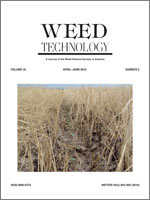Sprayer applicator-controlled variables, such as nozzle selection and spray volume, will become increasingly important for making labeled POST applications of dicamba in next-generation cropping systems. A field experiment was conducted in 2013 and 2014 at the Northeast Research and Extension Center in Keiser, AR. Tank mixtures of Engenia (a new form of dicamba), glyphosate, glufosinate, and S-metolachlor were applied with TeeJet AIXR, AITTJ60, and TTI nozzles. Two nozzle sizes, 11003 and 11006, were used to vary spray volume from 94 L ha−1 to 187 L ha−1, respectively. For barnyardgrass, a significant decrease in control was observed when spray volume was reduced for glyphosate dicamba in 2013. In 2014, an overall decrease in control was observed for the TTI nozzle when spray volume was reduced to 94 L ha−1, averaged across all herbicide treatments. The addition of the product S-metolachlor to glyphosate glufosinate dicamba significantly reduced the droplet spectra for all nozzle types. For example, adding S-metolachlor into the tank-mix decreased the volume median diameter (Dv50) for the TTI nozzle at 187 L ha−1 spray volume from 789 μm to 570 μm. The results from this research demonstrate that using low spray volume and coarser nozzles could reduce efficacy of the herbicides on the weed species evaluated. Nozzle selection and spray volume have key roles in maximizing efficacy of POST applications in dicamba-resistant crops. Additionally, evaluating droplet spectra of potential dicamba-containing tank-mixtures is critical for producing the desired droplet size to minimize off-target movement.
Nomenclature: Dicamba, N,N-Bis-(aminopropyl)methylamine (Engenia, BASF Corporation, Research Triangle Park, NC); glufosinate (Liberty, Bayer CropScience LP, Research Triangle Park, NC); glyphosate (Roundup PowerMax, Monsanto Company, St. Louis, MO); S-metolachlor (Dual Magnum, Syngenta Crop Protection, LLC, Greensboro, NC); barnyardgrass, Echinochloa crus-galli (L.) Beauv.
Las variables controladas por el aplicador, tales como la selección de la boquilla y el volumen de aspersión, serán cada vez más importantes para realizar aplicaciones POST de dicamba según la etiqueta, en los sistemas de cultivos de siguiente generación. En 2013 y 2014, se realizó un experimento de campo en el Centro de Investigación y Extensión del Noreste, en Keiser, Arkansas. Mezclas en tanque de Engenia (una nueva forma de dicamba), glyphosate, glufosinate, y S-metolachlor fueron aplicadas con boquillas TeeJet AIXR, AITTJ60, y TTI. Dos tamaños de boquillas, 11003 y 11006, fueron usados para variar el volumen de aspersión de 94 L ha−1 a 187 L ha−1, respectivamente. En el caso de Echinochloa crus-galli, se observó un a disminución significativa de su control cuando se redujo el volumen de aspersión con glyphosate dicamba, en 2013. En 2014, una disminución generalizada en el control fue observada con la boquilla TTI cuando el volumen de aspersión se redujo a 94 L ha−1, al promediarse todos los tratamientos de herbicidas. La adición del producto S-metolachlor a glyphosate glufosinate dicamba redujo significativamente el espectro de gota en todos los tipos de boquillas. Por ejemplo, el agregar S-metolachlor a la mezcla en tanque disminuyó el diámetro de volumen medio (Dv50) para la boquilla TTI a 187 L ha−1 de volumen de aspersión de 789 μm a 570 μm. Los resultados de esta investigación demuestran que el usar bajos volumen de aspersión y boquillas de gota más grande podría reducir la eficacia de los herbicidas en las especies evaluadas. La selección de boquilla y de volumen de aspersión tiene un papel clave para maximizar la eficacia de aplicaciones POST en cultivos r






